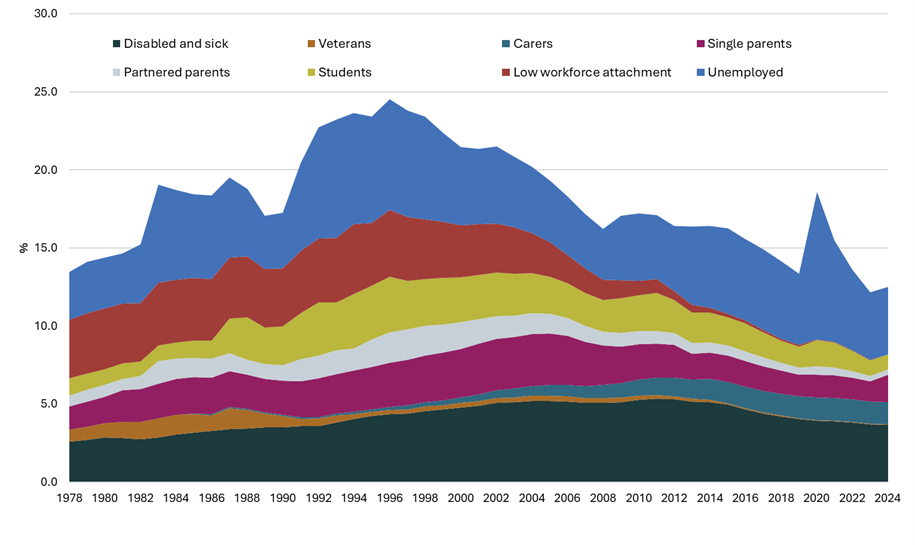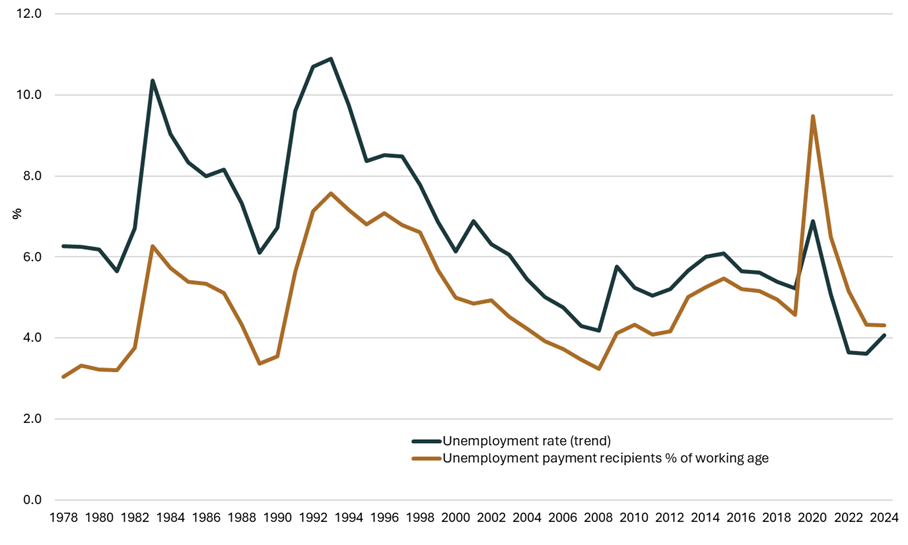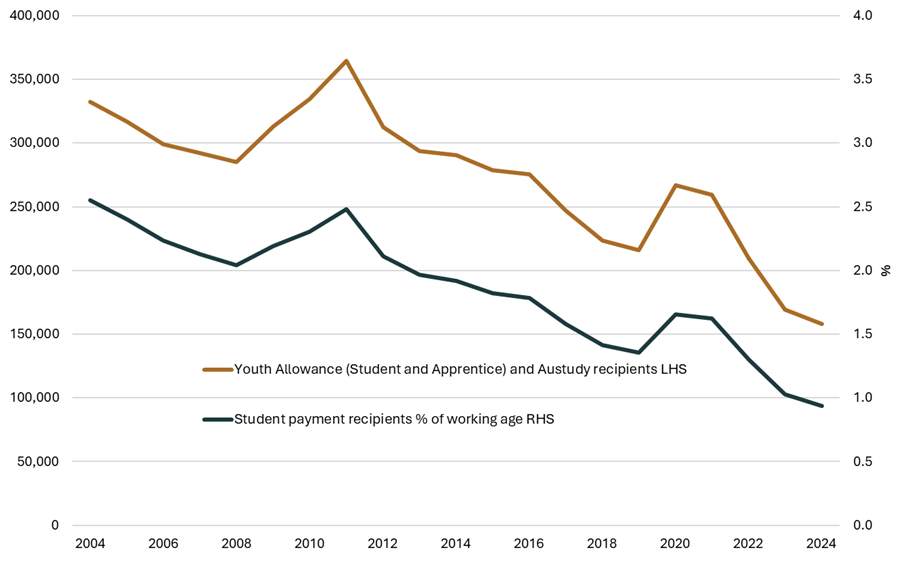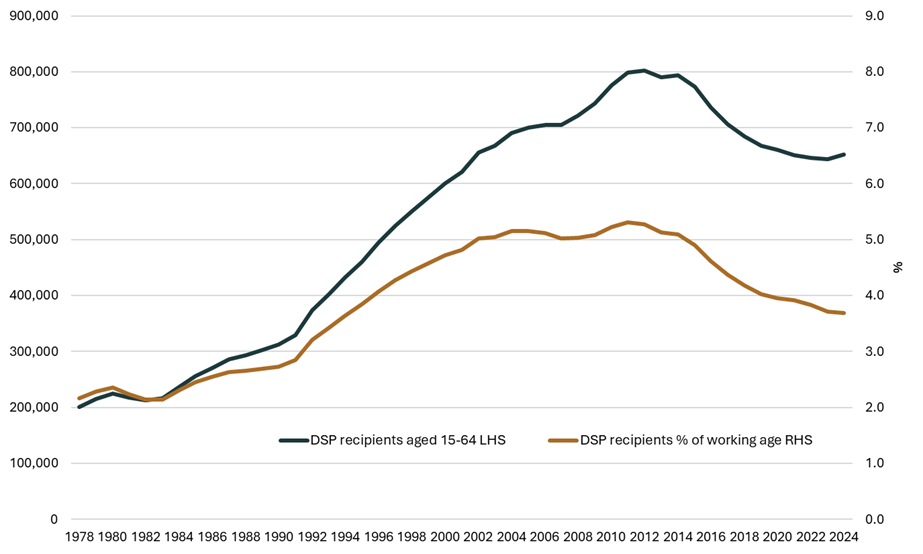Issue
The proportion of Australia’s population aged 15–64 receiving
income support payments reached record lows in 2023 and 2024. This was driven
by a strong labour market and pre-COVID-19 policy changes.
Key points
- In
June 2023, close to 12% of the population aged 15–64 received income support
payments—the lowest level in more than 45 years. June 2024 was only slightly
higher at around 13%.
- The
long-term decline in working-age welfare receipt is partly due to previous
governments’ policy changes restricting eligibility for some payments,
phasing-out other payments, and tight targeting through means testing.
- There
has been a marked decline in student payment recipients. Possible causes
include more students working and undertaking part-time study, parental
income tests limiting eligibility, and low payment rates discouraging
participation in higher education and course completion.
- There
has also been a significant decrease in Disability Support Pension
recipients, with some people with disability being directed onto the
lower-rate JobSeeker Payment.
Context
Australia’s social security system comprises means tested
payments aimed at different recipient categories. While the Age Pension is the
primary payment for retired older people, there are various income support
payments for working-age people requiring assistance due to disability,
unemployment, caring responsibilities or while studying. The proportion of this
working age population—those aged 15–64—receiving income support payments has
gradually declined since its peak following the early-1990s recession, with
short interruptions following the Global Financial Crisis in 2008 and COVID-19
containment policies in 2020 (Figure 1).
Figure 1 Income support recipients as a % of people
aged 15–64

Notes: See ‘Technical notes’ section. ‘Low workforce
attachment’ includes female Age Pension recipients aged under 65 years,
payments for widows, Bereavement Allowance (merged into JobSeeker Payment from
March 2020), Mature Age Allowance, Partner Allowance from 1996 and a percentage
of estimated dependent partners of allowance payment recipients 1978–94.
‘Veterans’ includes Service Pension and Income Support Supplement. Data
excludes JobKeeper and disaster payment recipients.
Sources: Parliamentary Library calculations based on Department
of Social Services (DSS), ‘DSS
Demographics’, and predecessor departments’ statistical papers; Department
of Veterans’ Affairs (DVA), ‘Pensioner
summary statistics’, from 2000 onwards; and Department of Education annual
reports. 2023 and 2024 data for some payments provided by DSS in response to
data request. Latest source available used where published data varies.
Population data from Australian Bureau of Statistics (ABS), National,
State and Territory Population, (ABS: Canberra, September 2024),
‘Population by age and sex – national’.
Prior to July 2017, the Age Pension qualifying age was 65
years—making 64 years a natural upper boundary for ‘working-age’. The Age
Pension qualifying age gradually
increased from 65 to 67 between 2017 and 2023. The qualifying age for women
was increased from 60 to 65 between 1995 and 2013. The change commencing in
2017 has resulted in more people 65 and over receiving payments previously
reserved for ‘working-age’ people. For example, in June 2024, there were 52,390
JobSeeker Payment recipients aged 65 and over.
Pre-COVID-19 decrease
In 1996, almost a quarter of Australia’s resident working-age
population received government income support. The subsequent decline was
driven by labour market improvements, changes in young people’s education
patterns and government
policy decisions (pp. 56–57). These policy changes included:
-
the increase in the Age Pension qualifying age for women
-
the phasing-out of payments primarily aimed at dependent partners
such as widow and wife pensions
-
restricting Parenting Payment eligibility to those with younger
children and introducing activity requirements
-
new Disability Support Pension qualification requirements and a
changed method for assessing impairments.
COVID-19 impact and
labour market recovery
The number of welfare recipients increased sharply following
implementation of COVID-19 containment policies but reliance on income support
did not reach previous peaks. Notably, the pandemic response policy measures (particularly
the JobKeeper
wage subsidy) prevented the 2020 numbers from escalating. In June 2020 around
3.6 million individuals were subsidised
through JobKeeper (p. 49). This represented around 20% of the working-age
population, excluding the approximate 230,000 aged
65 and over (p. 52) and approximately 130,000 people receiving
another income support payment. In total, an estimated 38% of the
population aged 15–64 received government income support in mid-2020.
A year later the Australian Government introduced a
new COVID-19
Disaster Payment to support those affected by state and territory
government COVID-19 lockdowns. By December 2021, around 2.4 million individuals
had received
this payment. Adding these people together with social security recipients
indicates close to 29% of the working-age population received income support in
the second half of 2021.
While pre-COVID-19 policy decisions contributed to the recent
record low rates of income support, the improved labour market has been the key
driver. The seasonally
adjusted unemployment rate plunged to 3.4% in October 2022, the lowest
level since the mid-1970s. It remained below 4% until December 2023, and as of
May 2025 is 4.1%.
Working-age income support receipt rates broadly follow
unemployment rate trends (Figure 2). While there is only
a partial overlap between unemployment payment recipients and those defined
as ‘unemployed’ in the ABS labour market surveys, unemployment rate trends
strongly correlate with trends in recipient numbers.
Figure 2 Trend unemployment rate and
unemployment payment recipients as % of working-age population

Notes: See ‘Technical notes’ section. Unemployment payments are
JobSeeker Payment and Youth Allowance (Other) and predecessor payments.
Sources: Parliamentary Library calculations based on DSS, ‘DSS
Demographics’, and predecessor departments’ statistical papers. 2023 and
2024 data payment data provided by DSS in response to data request. Latest
source available used where published data varies. Population data from
ABS, National,
State and Territory Population, (ABS: Canberra, September 2024),
‘Population by age and sex – national’. Unemployment rate from ABS, Labour
Force, Australia, (ABS: Canberra, April 2025).
Decrease in students
receiving income support
Recipients of student payments such as Youth Allowance
(Students and Apprentices) and Austudy have more than halved in the 20 years to
June 2024, from 341,900 to 166,100. As a proportion of the working-age
population, this dropped from around 3% in 2004 to under 1% (Figure 3). A policy
change in 2012 shifted students aged 16–17 from Youth Allowance to Family
Tax Benefit but student payment recipient numbers continued to decline in the
years following (p. 5).
Figure 3 Student income support recipients
aged 15–64

Notes: See ‘Technical notes’ section. Student payment totals
include Youth Allowance (Student and Apprentice) and ABSTUDY Living Allowance
recipients.
Sources: Parliamentary Library calculations based on DSS, ‘DSS
Demographics’, and predecessor departments’ statistical papers. 2023 and
2024 payment data provided by DSS in response to data request. Latest source
used where published data varies. Population data from ABS, National,
State and Territory Population, (ABS: Canberra, September 2024),
‘Population by age and sex – national’.
In 2023, higher education researcher Andrew Norton observed
that student income support numbers are in a ‘structural decline that COVID-19
interrupted’ and that ‘no in-depth research explains the decrease’ (p. 66). The
subsequent Australian
Universities Accord Final Report (released in February 2024) suggested some
possible causes, including (pp. 144–5):
-
a strong labour market increasing the number of students combining
work and study
-
people deferring study to enter the labour market
-
increased part-time study, which generally prevents income
support eligibility
-
a narrowed parental income test, reducing the number of students
eligible for payments
-
independence criteria limiting eligibility and encouraging rural
and regional students to defer study
-
inadequate payment rates, discouraging participation and lowering
completion rates.
In response, the report
recommended increasing the parental income test free area and changing
indexation arrangements. It also advocated expanding eligibility to part-time
students (50%–74% study load) with a pro-rata payment and further government technical
analysis of the identified issues (p. 150).
People with disability
receiving income support
There has also been a marked decline in the number of
working-age Disability Support Pension (DSP) recipients since 2011 and 2012
(Figure 4). In a 2018 report, the
Parliamentary Budget Office stated that the main driver of the slowdown in
DSP expenditure growth after 2012 was policy measures reducing the flow of
people onto the payment, particularly new assessment measures (p. vi).
Figure 4 Disability Support Pension recipients
aged 15–64

Notes: See ‘Technical notes’. DSP was known as the Invalid
Pension prior to 1991.
Sources: Parliamentary Library calculations based on DSS, ‘DSS
Demographics’, and predecessor departments’ statistical papers. Population
data from ABS, National,
State and Territory Population, (ABS: Canberra, September 2024),
‘Population by age and sex – national’.
While some found paid employment, many people with
disability who would have previously received DSP have moved onto other
payments, particularly the lower-rate JobSeeker Payment. The proportion of
JobSeeker (and predecessor payment) recipients assessed as having a ‘partial
capacity to work’ has grown from
less than 10% in 2007 (p. 20) to around
41% in 2025. These individuals are subject to different mutual obligation
requirements than other JobSeeker Payment recipients.
DSP policy changes have contributed to a significant demographic
change in JobSeeker Payment—it is no longer the payment for those seeking
full-time work. Approximately 40% of recipients have a disability and can only
work part-time. As JobSeeker absorbed
the former Sickness Allowance in 2020, there are also now recipients who
have a job or are studying but are temporarily unable to work or study due to a
medical condition.
Conclusion
The record numbers of working-age people in paid employment
is a significant achievement. However, the low numbers of working-age people
receiving welfare payments tells us little about how the income support system performs.
The system is intended to support those with full or limited capacity to engage
in or find work—recipient numbers are primarily driven by the overarching
economy.
Despite the potential to connect welfare receipt trends with
claims of program effectiveness, the data is only one measure. A much
broader analysis is required to sufficiently assess the appropriateness of
payment settings for different recipient categories or for achieving particular
objectives.
Beyond the headline figures, there are significant
demographic shifts happening within payment categories and missing from the
picture are the stories of those unable to find work but ineligible for income
support.
Technical notes
Data for all figures is at June of each year unless
point-in-time data unavailable.
Department of Social Services data
Prior to 2023, data sources report recipients of JobSeeker
Payment (and predecessor payments) and Special Benefit who are determined to be
current (i.e. entitled to be paid/not suspended) on the Centrelink payment
system, and not in receipt of zero rate of payment; and recipients of ABSTUDY
(Living Allowance), Austudy, Parenting Payment and Youth Allowance who are similarly
determined to be current (entitled to be paid/not suspended). In January 2023
the Department of Social Services revised reporting populations for income
support recipients. Published reporting populations now include all current
(including those on zero rate of payment) and suspended recipients. The data
used in this policy brief will not be wholly comparable to other published data
as it does not include zero rate JobSeeker Payment and Special Benefit
recipients or recipients suspended from payment.
Trend unemployment rate (Figure 2)
The unemployment rate measures unemployed persons as a
percentage of the labour market (population aged 15 years or over who are
employed or unemployed and actively looking for work). Due to large
month-to-month labour market changes during April 2020 to March 2022, the ABS
recommends using caution regarding the trend estimates for this period.